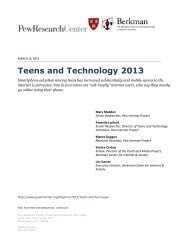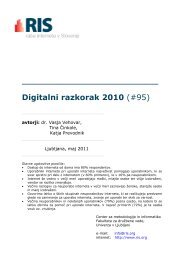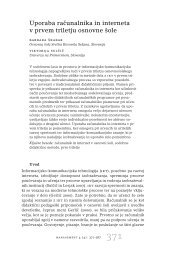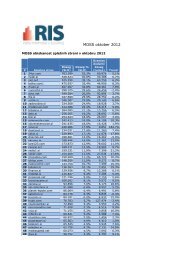the Labour Market Survey Report - Council of European ...
the Labour Market Survey Report - Council of European ...
the Labour Market Survey Report - Council of European ...
Create successful ePaper yourself
Turn your PDF publications into a flip-book with our unique Google optimized e-Paper software.
- “Skills Framework for <strong>the</strong> Information Age” (SFIA) - developed with active steer from industry, has<br />
considerable merit, but needs even greater buy-in. Details can be found at www.e-skillsnto.org.uk/sfia/.<br />
The only framework <strong>of</strong> an international character developed thus far arose from an initiative by a number<br />
<strong>of</strong> large <strong>European</strong> ICT companies, which led to <strong>the</strong> development <strong>of</strong> <strong>the</strong> “career-space” framework. Since<br />
this is intended first and foremost for careers promotion purposes, it is a relatively “coarse-grained”<br />
framework (with thirteen generic job pr<strong>of</strong>iles, including Communications specialisms), and it is only 1-<br />
dimensional – i.e. it does not directly reflect <strong>the</strong> fact that different occupations exist at different levels <strong>of</strong><br />
technical complexity and responsibility. More details can be found at www.career-space.com.<br />
It is important to recognize that – for a fast moving set <strong>of</strong> industrial sectors and occupations – <strong>the</strong> task<br />
<strong>of</strong> tracking development in a robust quantitative way will always be very difficult. All occupational<br />
frameworks in such an environment need to have review and updating built in. Even more difficult in<br />
that situation is <strong>the</strong> task <strong>of</strong> forecasting future skill needs, both in terms <strong>of</strong> “competence-content” and <strong>of</strong><br />
development <strong>of</strong> numbers required in <strong>the</strong> labour market as a whole, since trend data is lost if a single<br />
occupational framework cannot be sustained.<br />
Probably <strong>the</strong> most important principle to be understood when trying to develop a sound view <strong>of</strong> IT<br />
Practitioner skills is to recognize <strong>the</strong> fundamental distinction between <strong>the</strong> sector and occupational<br />
perspective. IT (supplier) companies arise from, and are strongly influenced by, <strong>the</strong> abilities <strong>of</strong> <strong>the</strong><br />
“technical people”. But such companies generally also employ people with a range <strong>of</strong> o<strong>the</strong>r skills, in<br />
support operations <strong>of</strong> various kinds (e.g. accounts people, admin. people, marketing and sales people,<br />
personnel staff, general managers, <strong>of</strong>fice cleaners, etc.). In addition, organizations in most o<strong>the</strong>r parts<br />
<strong>of</strong> <strong>the</strong> economy – e.g. banks, manufacturing companies, local authorities, hospitals (and o<strong>the</strong>r health<br />
care operations), airlines, retail businesses, government departments, etc. - all make considerable<br />
use <strong>of</strong> Information Technology, and in doing so, generally have “IT departments” that employ teams<br />
<strong>of</strong> IT Practitioners. In many countries, <strong>the</strong> number <strong>of</strong> IT practitioners employed in <strong>the</strong>se “IT user<br />
organizations” is greater than <strong>the</strong> numbers employed in IT (supplier) companies. Table A-1 shows <strong>the</strong><br />
structure in its simplest form: a 2 x 2 matrix. The numbers <strong>of</strong> people employed in <strong>the</strong> 4 boxes show <strong>the</strong><br />
basic pr<strong>of</strong>ile <strong>of</strong> a country’s IT practitioner community.<br />
Note that this report makes no attempt to describe <strong>the</strong> skills position <strong>of</strong> “IT End-Users” – <strong>the</strong> (millions)<br />
whose main job is not IT, but who use IT - <strong>of</strong>ten very considerably - in <strong>the</strong>ir work. While many “End-<br />
Users” are extremely capable “drivers” <strong>of</strong> powerful s<strong>of</strong>tware tools, <strong>the</strong>y are not IT practitioners until <strong>the</strong>y<br />
shift over (as many hundreds <strong>of</strong> thousands undoubtedly do within Europe each year) into employing<br />
<strong>the</strong>se skills essentially for <strong>the</strong> benefit <strong>of</strong> o<strong>the</strong>rs.<br />
Telecommunications and Electronics sectors and occupations and Convergence<br />
Recent developments in digital technology have accelerated <strong>the</strong> convergence <strong>of</strong> a series <strong>of</strong> related<br />
technologies and markets. This convergence is very important and will fur<strong>the</strong>r increase <strong>the</strong> impact <strong>of</strong><br />
<strong>the</strong>se technologies on most aspects <strong>of</strong> our lives. It is also introducing fur<strong>the</strong>r complexity into attempts<br />
to clarify <strong>the</strong> labour markets involved.<br />
The approach <strong>of</strong> this study is, while recognizing <strong>the</strong>se realities, to emphasise <strong>the</strong> occupational view<br />
<strong>of</strong> <strong>the</strong> world, since, while new products and services will continue to spawn fast-growing new sectors<br />
which will need a range <strong>of</strong> different technical skills, <strong>the</strong> key underlying occupational differences – e.g.<br />
between s<strong>of</strong>tware development and electronics design and technical skills - will remain.<br />
C E P I S I.T. PRACTITIONER SKILLS IN EUROPE | Annex A | 95

















